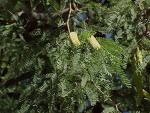Prosopis Velutina Tree Information
Images of Prosopis Velutina:






Prosopis Velutina grows in the following 4 states and provinces:
Arizona, California, New Mexico, TexasInformation about Prosopis Velutina:
as well ashe Prosopis Velutina is commonly known as the Velvet Mesquite.
The currently accepted scientific name of velvet mesquite is Prosopis velutina Woot.(Fabaceae). There are no infrataxa . Inter- and intraspecific hybridization within mesquites (Prosopis spp.) is common. Many intermediate forms exist, making identification difficult at the specific or varietal level. Before settlement of the Southwest by Europeans, speceis were separated by geographic barriers. With the introduction of livestock, mesquites have spread, and now have a more or less continuous distribution across the Southwest, which allows for increased hybridization . The ranges of velvet mesquite and western honey mesquite (P. glandulosa var. torreyana) overlap in western Arizona and hybrids are common . Plants in the vicinity of Guaymas, Sonora, and La Pas, Baja California combine characteristics of velvet mesquite, western honey mesquite, and honey mesquite (P. glandulosa var. glandulosa) .The main distribution of velvet mesquite is confined to central and southern Arizona, extreme southwestern New Mexico, and adjacent northern Mexico . The eastern boundary of its range is near the Continental Divide in southern New Mexico . The Continental Divide forms a natural boundary between populations of velvet mesquite and honey mesquite (var. uncertain) . In California, velvet mesquite is represented by only a few individuals that occur in Imperial, Riverside, and Kern counties . This population is believed to be from human introductions. A small, isolated population occurs in the Rio Grande Valley, near El Paso, Texas , that is also thought to be introduced.Velvet mesquite occurs in low elevation vegetation types, including paloverde (Cercidium microphyllum)-bursage (Franseria deltoidea) cacti (Opuntia spp.), desert grasslands, oak woodlands, and pinyon-juniper (Pinus edulis-Juniperus spp.) woodlands . In desert grasslands, it may be found in high enough densities to form "brushy ranges", but in the other vegetation types it is generally found as scattered individuals. Along major water coarses and their tributaries, however, deciduous woodlands or "bosques" are often dominated by velvet mesquite. Shrubby associates in desert grasslands include viscid acacia (Acacia vernicosa), whitethorn acacia (A. constricta), catclaw acacia (A. greggii), graythorn Condalia lycoides), ironwood (Olneya tesota), burroweed (Haplopappus tenuisectus), hackberries (Celtis spp.), tarbush (Flourensia cernua), and paloverde . In drainage basins, velvet mesquite often occurs in relatively pure stands of tobosa grass (Hilaria mutica). On heavy-textured upland soils, velvet mesquite occurs in pure stands of tobosa or sacaton (Sporobolus wrightii) . Velvet mesquite is often interspersed in low elevation oak woodlands dominated by Emory oak Quercus emoryi), Mexican blue oak (Q. oblongifolia) and Arizona white oak (Q. arizonica) . Mesquite bosques were typically open and parklike. Velvet mesquite often forms nearly pure stands in these riparian situations but may also be interspersed with other trees and shrubs such as netleaf hackberry (Celtis reticulata), wolfberry (Lycium spp.), Mexican elder (Sambucus mexicana), Southwestern condalia (Condalia obovata), and fourwing saltbush (Atriplex canescens) . The understory was historically dominated by vine mesquite grass (Panicum obtusum), careless weed (Amaranthus palmeri), and in saline areas, by saltbushes (Atriplex spp.). Today, because of grazing and other disturbances, many bosques have been invaded by introduced grasses and forbs, including cutleaf filaree (Erodium cicutarium), mustard (Sisymbrium irio), red brome (Bromus rubens), and schismus (Schismus barbatus) .Some of the information provided here is attributed to:Uchytil, Ronald J. 1990. Prosopis velutina. In: Fire Effects Information System, [Online]. U.S. Department of Agriculture, Forest Service, Rocky Mountain Research Station, Fire Sciences Laboratory (Producer). , available at the USDA Fire Effects Information System (FEIS) website